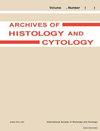Sustained treatment with a GnRH agonist (leuprorelin) affects the ultrastructural characteristics of membranous organelles in male rat pituitary gonadotropes
Q4 Medicine
引用次数: 4
Abstract
Summary. Gonadotropin-releasing hormone agonists exert acutely stimulatory action on gonadotropes, but thereafter suppress paradoxically gonadotropin synthesis and release by receptor desensitization. To examine whether GnRH signaling affects the morphological characteristics in membranous organelles related to the synthesis of gonadotropin, we have analyzed the ultrastructural changes in the ER and Golgi apparatus of male rat pituitary gonadotropes during sustained treatment with a GnRH agonist, leuprorelin. In pituitary gonadotropes at 1 day after the onset of treatment, clusters of the tubuloreticular ER appeared, and the globular Golgi apparatus was transiently disassembled into isolated small-sized stacks. However, 1 week after the onset of the treatment, the tubuloreticular ER was seemingly converted to rough ER with regularly stacked sheets and the scattered Golgi stacks converged to form globular structures. In the following chronic phase of the treatment, the ER cisterns remained flattened and the trans-Golgi compartment appeared to be collapsed. Sustained treatment with leuprorelin could also restore the enlarged Golgi apparatus and expand the cisterns of the rough ER; a feature that was seen in hypertrophic gonadotropes of castrated rats. These findings indicated that the ultrastructure of the membranous organelles changed because of the chronic suppressive effects of leuprorelin on gonadotropes both in the physiological and stimulated states. The acute and chronic ultrastructural changes in the ER and Golgi apparatus during sustained leuprorelin treatment also suggests that GnRH signaling cross-talks with the regulation of the morphological characteristics in membranous organelles related to gonadotropin synthesis. generating secretory granules, in this study we have investigated the temporal changes in the ultrastructure of the ER and Golgi apparatus in pituitary gonadotropes of male rats receiving 1-month depot formulation of leuprorelin. Based on the findings, we will discuss the putative crosstalk between GnRH signaling and the regulation of the structural properties of the ER and Golgi apparatus within gonadotropes.持续使用GnRH激动剂(leuprorelin)影响雄性大鼠垂体促性腺激素膜细胞器的超微结构特征
总结。促性腺激素释放激素激动剂对促性腺激素发挥急性刺激作用,但随后通过受体脱敏抑制促性腺激素的合成和释放。为了研究GnRH信号是否影响与促性腺激素合成相关的膜细胞器的形态学特征,我们分析了雄性大鼠垂体促性腺激素在持续使用GnRH激动剂leuprorelin治疗期间内质网和高尔基体的超微结构变化。在垂体促性腺激素治疗开始后1天,出现管网状内质网簇,球状高尔基体瞬间分解成孤立的小堆。然而,在治疗开始1周后,管网状内质网似乎转变为粗糙的内质网,有规则的堆叠片,分散的高尔基堆积聚集形成球状结构。在随后的慢性期治疗中,内质网池保持扁平,反式高尔基隔室出现塌陷。持续用leuprorelin治疗也能恢复扩大的高尔基体,扩大粗ER池;这一特征在去势大鼠的增生性促性腺激素中可见。这些结果表明,由于leuprorelin对促性腺激素在生理和刺激状态下的慢性抑制作用,膜细胞器的超微结构发生了变化。持续leuprorelin治疗期间内质网和高尔基体的急性和慢性超微结构变化也表明GnRH信号与促性腺激素合成相关的膜细胞器形态特征的调节交叉对话。在本研究中,我们研究了雄性大鼠垂体促性腺激素给药1个月后,内质网和高尔基体超微结构的变化。基于这些发现,我们将讨论促性腺激素信号传导与内质网和高尔基体结构特性调节之间可能存在的串扰。
本文章由计算机程序翻译,如有差异,请以英文原文为准。
求助全文
约1分钟内获得全文
求助全文
来源期刊

Archives of histology and cytology
生物-细胞生物学
自引率
0.00%
发文量
0
期刊介绍:
The Archives of Histology and Cytology provides prompt publication in English of original works on the histology and histochemistry of man and animals. The articles published are in principle restricted to studies on vertebrates, but investigations using invertebrates may be accepted when the intention and results present issues of common interest to vertebrate researchers. Pathological studies may also be accepted, if the observations and interpretations are deemed to contribute toward increasing knowledge of the normal features of the cells or tissues concerned. This journal will also publish reviews offering evaluations and critical interpretations of recent studies and theories.
 求助内容:
求助内容: 应助结果提醒方式:
应助结果提醒方式:


